"I stopped worrying a long time ago about whether what I do
is art or science; otherwise, I'd rip my brain apart."
"There are changes on the horizon that are so dramatic and
sweeping that all of the revolutions of the so-called digital age will
shrink by comparison. All of our dreams are going to come true. So we will
have to have the right kinds of dreams. That is why science needs artists
like me."
Art as a Form of Life
More copies exist of one of his works than of all previous artworks by all prior artists. Yet his self-replicating creations have never been exhibited in the United States.
|
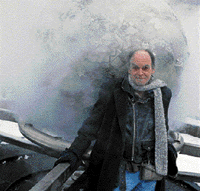 |
| Photograph by Kathleen Dooher |
| Davis with one of his more conventional artworks. |
FAST FACTS:
|
CAMBRIDGE, MASS.--Either Joe Davis is late or I am lost. I check my watch and look for the third time at the address he gave me for the studio where he creates his avant-garde art: Massachusetts Institute of Technology, building 68, sixth floor, room 604D. Here it is, locked and looking nothing like an artist's workshop. "SEVERE EYE DAMAGE" cautions a sign on the door, referring to a laser (not the artworks) inside. There are trash bins marked "WARNING: RADIOACTIVE WASTE," walk-in refrigerated vaults containing cells in stasis, ultracentrifuges the size of washing machines. But no paints, no cameras, no sculpting tools.
I wander downstairs to the office of Alexander Rich, the biophysicist who famously discovered left-handed DNA (the normal stuff twists to the right), who worked out the structure of transfer RNA, who last year won the $250,000 Bower award, and who invited Davis into his lab in 1992 as a "research affiliate," which grants Davis a space to work and access to the lab's expensive tools but no financial support. There is still no sign of Davis, until I press my nose against the window of a door into a small white room.
The room is warm: 98.6 Fahrenheit, the temperature of the human bowel. There, on wire shelves next to flasks in which swim various strains of gastrointestinal bacteria, sit five mason jars marked "Self-Assembling Clock." In each jar rest the jumbled parts of a disassembled timepiece. I recognize this as Davis's work, part of his six-year-old "experiment" to test whether whether, given the right conditions and enough time, the components of machines can self-assemble into working devices, just as life supposedly arose spontaneously from colliding precursory biochemicals billions of years ago. That theory, still unproved despite almost 40 years of research, suddenly strikes me as less plausible and yet more profound.
Tick tick. I turn to see Davis walking down the hall, his selfmade peg leg clacking, steel on tile. The test tube stopper plugging its end has worn down. Ask him how he lost the limb, as someone does at his fiftieth birthday party the following night, and he raises an eyebrow, inhales deeply and recites one of his poems, a dark, frightening, erotic poem of slithering asps, black waters and an embrace with the long, luscious lips of an alligator.
Ask his friends, and they say he lost the leg in a motorcycle crash 20 years ago, when he was still a sculptor and bike mechanic in Mississippi. That is where he grew up with his chemist father and five siblings, until problems at school got him sent up to the grandparents in Delaware and to a psychiatric evaluation at age 13. In his report, Dr. Jastak suggested that young Joe should "apply his artistic abilities to his scientific ventures," maybe even pursue a career as a scientific artist. Quite a prescient forecast for 1964, although Jastak probably imagined Davis drawing pictures of atomic airplanes for a living.
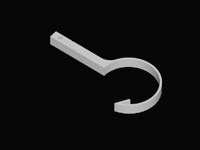 |
| Courtesy Ars Electronica Festival 2000. Copyright Joe Davis. |
| Design for a microbial fishhook. |
Davis himself had altogether different ideas about how science and art could be coaxed or forced together, ideas that have often made both professions uncomfortable. For seven years he championed a space shuttle experiment that would have shot a 100,000-watt electron gun into the magnetosphere to create the first artificial aurora. After selling his Harley to fund the design and touring the lecture circuit as the default spokesman for art in space, Davis finally persuaded the National Aeronautics and Space Administration (NASA) to accept the payload, only to see it scuttled when the Challenger exploded.
No matter; he was already plotting other ways to make artistic use of high-voltage electricity and spacebound signals. In the early 1980s, he drew up plans for channeling lightning bolts into a pulsed laser of almost unparalleled energy and into towering sculptures that would change the bolts' color and emit incredibly loud tones—designs that also remain unbuilt, awaiting a sponsor. Later that decade, Davis led a quasi-covert operation that recorded the vaginal contractions of ballerinas with the Boston Ballet and other women, then translated this impetus of human conception into text, music, phonetic speech and ultimately into radio signals, which were beamed from M.I.T.'s Millstone radar to Epsilon Eridani, Tau Ceti and two other nearby star systems.
The Air Force soon found out about the million-watt Poetica Vaginal broadcast, as Davis calls it, and shut it down. But the 20-minute message was many times longer than the the first deliberate attempt to say hello to extraterrestrial ham radio operators, a string of 1,679 bits that Carl Sagan and Frank Drake beamed from the giant dish in Arecibo, Puerto Rico, 26 years ago. That message, like every engraved plaque and recorded video disk that NASA allowed on the Pioneer and Voyager space probes, made no attempt to convey what aliens would probably be most curious to know about humans: how we reproduce.
"The images of humans placed aboard the Pioneer 10 and 11 spacecraft show impeccably groomed men that lack any facial and body hair," Davis hoots, "and women with no external genitalia." Poetica Vaginal was in part a response to this curious censorship. "By making this attempt to communicate with the other," he explains, "we're really communicating with ourselves."
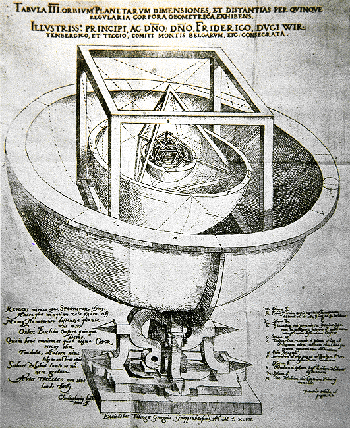 |
| Courtesy Ars Electronica Festival 2000. Copyright Joe Davis. |
| Kepler's nested polyhedra; blueprint for a supervirus? |
"This is probably one of the strangest art collections on earth," Davis says, as he opens the door to a refrigerated room. I enter and follow his gesture to a rack of urine-colored liquids in bottles. "This is sort of the ski resort of the farm," he says—the "farm" being Davis's term for the menagerie of paramecia, stentors, rotifers and other assorted protozoans that he cultivates as artistic and scientific media. Back in his lab, Davis sits down next to a jury-rigged assemblage of borrowed lasers, optics and stereo equipment and shows me the movies he made of these microanimals. They are mildly interesting to look at, but extraordinary to hear. His documentaries of the lives of cells have soundtracks, recorded from a scanning laser as the protozoans squirm beneath it. On the shelf above Davis's head are more pens in the farm, mason jars labeled either with scientific names or with pet names such as scary finbacks and green scudders. Davis says the he has spent enough time listening to their behavior that he can now distinguish many species from their microacoustic signatures alone.
"The audio microscope originated from a conversation with a medical student who had just returned from fieldwork in Ecuador," Davis says. "She told me she heard a story from a magician, a witch doctor, about a certain plant in the mountains that sings a different song than plants of the same species in the valley. She asked whether there any way she could listen to this singing. A lot of things are inspired by questions people ask me."
Watching and hearing microorganisms dance about made Davis wonder what it would be like to feel them move. What if he could somehow set up a rod and tackle to fish for stentors? On the face of it, this is a crazy idea: stentors are trumpet-shaped animals just a couple hundred microns long. Davis found a fellow in the micromachine lab who was willing to etch 25-micron fishhooks in the margin of his microchip design, but after the first two attempts failed Davis has decided to make his own photolithographic templates. The two have worked out a way to thread microfibers through the eyes of the hooks and melt them in place. David Gessel, an engineer with Nebucon who has aided Davis on several projects, has sketched out a scheme for making a fishing rod. Sensors connected to the fiber would control servos to make the miniscule tug of stentor feel like the jerking head of a marlin.
As Davis describes his plans, his eyes squint with intensity, giving the grizzled 50-year-old man an almost boyish expression of awe at the weirdness of nature and the power of technology to poke at it. His enthusiasm is contagious; it makes me wonder whether I could watch a protozoan take my hook, listen to it thrash, break a sweat as I fight it to a draw, and yet not come away with a new perspective on the ocean of microscopic life in which we are immersed, usually imperceptibly.
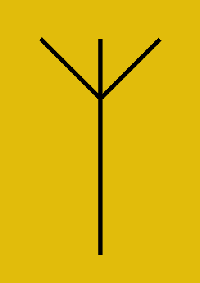 |
| Courtesy Ars Electronica Festival 2000. Copyright Joe Davis. |
| The Microvenus icon. |
It was about 15 years ago that Davis first realized that genetic engineering was creating a rich new medium for art—life itself. He convinced molecular biologists at Harvard Medical School and the University of California at Berkeley to teach him how to synthesize DNA and insert it into the genomes of living bacteria. That took some persistence: "In the beginning scientists were not comfortable talking to me," Davis recalls. "It took a while for them to trust me with their secrets." That is probably a good thing, he admits. "I still come up with ideas that are dangerous and don't realize that they are dangerous. For example there is a 200-mer [a sequence of 200 amino acids] that folds into a highly geometric capsule. I had this idea of creating Kepler's nested polyhedra [once thought to define the planetary orbits] in these viral capsids." Fortunately, Davis ran the idea by one of his genetics mentors first. "He pointed out that I could inadvertently create a supervirus."
Instead Davis set about creating what he calls "an infogene, a gene to be translated by the machinery of human beings into meaning, and not by the machinery of cells into protein." His idea was to send a message in a bottle to extraterrestrials: to genetically engineer a sign of human intelligence into the genome of bacteria, grow them up by the trillions and fling them out across the heavens, to land where they may. Like Poetica Vaginal, the real message was of course aimed not at aliens but at a public that has yet to digest the fact that DNA can encode any information, not just genetic sequences.
For his bottle, Davis chose E. coli, a bacterium on which humans depend for proper digestion and one that, in NASA experiments, has survived more than five years of exposure to the intense cold and radiation of deep space. For his message, he selected Microvenus, a simple symbol—like a Y and an I superimposed—that is both a Germanic rune representing life and an outline of the external female genitalia.
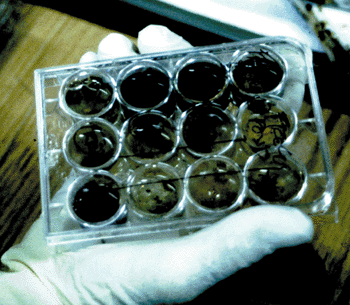 |
| Courtesy Ars Electronica Festival 2000. Copyright Joe Davis. |
| Palmtop gallery: billions of E. coli with Microvenus encoded in their genomes. |
Digitized and translated into a string of 28 DNA nucleotides, Microvenus first slipped between the genes of E. coli in 1990. The bacteria quickly multiplied in its beakers into billions of cells, each carrying a separate instance of the icon. "I'm probably the most successful publisher in history," Davis says with a laugh. "There are more copies of my work than of Salvador Dali's, Escher's and all the rest of them put together."
Without a doubt, Microvenus was the most highly reproduced graphic that almost no one had ever seen, because no gallery has been willing to risk the public display of genetically engineered bacteria in the U.S. It was not until last September that Microvenus was finally put on public display in a positive-pressure biological containment facility erected at the Ars Electronica exhibition in Linz, Austria. Visitors could see cultures of the transgenic bacteria along with posters of the icon and explanations of how and why the image was encoded into the E. coli genome.
And it was at Linz that Davis was also able for the first time to exhibit Riddle of Life, a second genetic artwork he created in the mid-1990s. That project began when he learned about a classic rivalry in the history of genetics, between physicist Max Delbruck and biologist George W. Beadle. "This was back before they had worked out the code that matches 20 distinct triplets of DNA nucleotides to the 20 amino acids," Davis explains. "They didn't even know whether there were 'spaces' that separated each triplet." Delbruck believed DNA must contain spaces between its "words;" Beadle disagreed.
In 1958 Beadle was awarded the Nobel Prize (as was Joshua Lederberg). On learning the news, Delbruck and his co-workers dashed off a telegram encoded as a continuous string of 229 As, Bs, Cs, and Ds. Beadle quickly surmised that the four letters symbolized the four bases of DNA, broke the telegram into triplets and decoded the message: "BREAK THIS CODE OR GIVE BACK THE NOBEL PRIZE LEDERBERG GO HOME MAX MARKO STERLING".
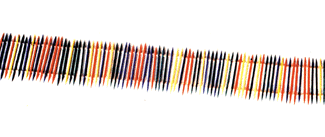 |
| Courtesy Ars Electronica Festival 2000. Copyright Joe Davis. |
| The Riddle of Life, in toothpicks. |
The next day, Beadle sent Delbruck a telegram written in a different four-letter code—one that lacked a space character. Delbruck soon solved the puzzle and read the note: "GWBTOMDIMSUREITSAFINEMESSAGEIFICOULDDOTHEFINALSTEP".
Not one to be gainsayed, Delbruck conspired to get the final word. "As Beadle stepped up to the podium in Stockholm to receive his award from the king, a courier walked in," Davis narrates, his eyes widening. "He handed Beadle a ladderlike toothpick model, each rung stained in one of four colors. Beadle decoded the message on the spot," Davis says, his voice trailing to a whisper. "I AM THE RIDDLE OF LIFE. KNOW ME AND YOU WILL KNOW YOURSELF," read the toothpicks. "I found that so moving, so moving," Davis says.
Inspired by the story, Davis worked out a logical code for translating the language of English into the language of life. (Delbruck's and Beadle's codes were arbitrary.) He cloned the DNA sequence representing the "Riddle of Life" quotation and sequestered it safely in a noncoding part of the E. coli genome. Then he sequestered the E. coli in a safe part of the Rich lab, where it has remained ever since. (The Riddle of Life organisms shown in Linz were created from scratch in Europe.)
In a keynote lecture at the Ars Electronica exhibition, Davis described his most ambitious transgenic artwork yet: putting an image of the Milky Way into a mouse's ear, an idea inspired by a children's story written 30 years ago by a girlfriend. In order to encode such a large amount of binary information in DNA, he spent years figuring out a general method for archiving computer databases in biological form, a "supercode" that guarantees the infogene will be biochemically stable and yet prevents the host from translating it into protein.
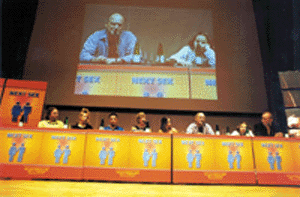 |
| Courtesy Ars Electronica Festival 2000. Copyright Joe Davis. |
| Davis at Ars Electronica 2000. |
Despite his professional success—widely acknowledged as a pioneer of transgenic art, he gave 14 invited lectures last year at universities and conferences—Davis still remains utterly dependent on donations of equipment and expertise from scientists. "They are increasingly skittish about getting too close for fear of the wrong kind of publicity," he says. "Fortunately, Joe's always been a good Tom Sawyer of people," Gessel observes. "It helps that he is consistently rigorous in his intellectual approach," and that he isn't in it for money. Indeed, because he sells his conventional sculptures to friends at cost and cannot sell his transgenic art at all, even now Davis flirts on the verge of homelessness, with no fixed address. He returned from Europe last fall to find an eviction notice on his door. Much of what he rescued from the sheriff's auction is now jammed into a decrepit Volvo station wagon that he obtained in trade for a self-assembling clock. Davis keeps Mississippi plates on the car, even though he hasn't lived there in decades, to squeeze through a loophole that exempts it from property taxes.
As I leave Davis's office and walk past the M.I.T. Media Lab, where so many millions of corporate dollars have chased so many abortive attempts to weave technology into a cultural fabric, it strikes me as unwise and even perverse that the same society offers so little support for art that does not merely comment passively on the transformations and ethical dilemmas that science forces on society but rather actively enacts and illustrates them, coopting the tools and media of science itself.
--W. Wayt Gibbs
